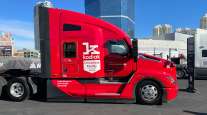Data Collection and New Technology Bring ADAS Improvements
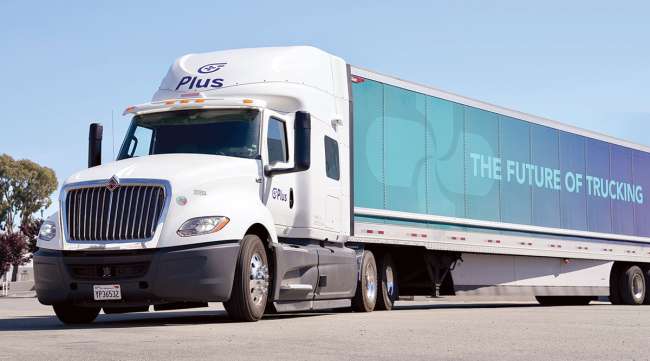
[Stay on top of transportation news: Get TTNews in your inbox.]
The technology powering advanced driver assistance systems is continuing to improve, laying the groundwork for more autonomous driving and creating significant safety and maintenance benefits.
“ADAS technology is continuing to improve and evolve over time, from the software to hardware, including radar, lidar and cameras; the quality, cost and range offered are being extended,” said Shawn Kerrigan, chief operating officer of Plus. “There continue to be advancements along the entire spectrum of ADAS.”
Computing power, memory and communication speed between the different elements, such as cameras and radar, are advancing. “The technology is moving on and getting better to do more,” said Dirk Wohltmann, director of engineering for ZF Group. “The better the sensors, the more precise they are, and the better we can build off it.”
Better sensors allow manufacturers to bring more functions together, increasing their ability. Wohltmann said radar, unlike a camera, doesn’t need light or good visibility and can see distance accurately, but it can’t identify the object like a camera. “Now we can combine what can really see the distance — radar — with the camera, which can tell this is a human, a vehicle or a bridge. This helps us be much better and more precise on our prediction.”
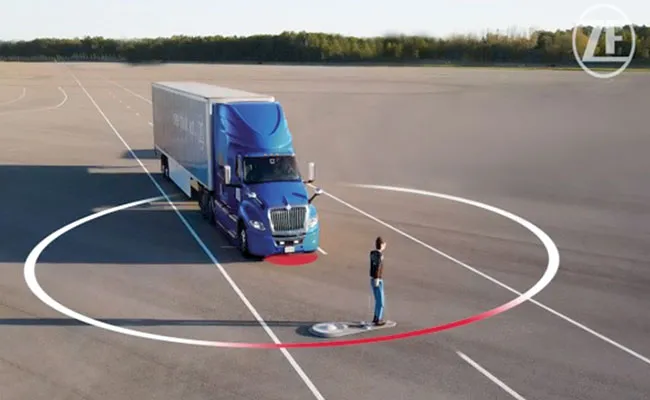
ZF Group has rolled out safety assistance features that can detect traffic signs and pedestrians, among other things. (ZF Group)
ADAS includes basic SAE Level 2 autonomous features, such as automatic emergency braking, to highly automated driving features, through which the truck can operate in supervised autonomy mode. Kerrigan said Plus’ ADAS solutions within PlusDrive offer semi-autonomous features based on the company’s Level 4 autonomous driving software.
Kevin Chronicle, head of sales and marketing for commercial vehicle and new EV customers, automotive steering for Bosch in North America, is seeing significant advancements in ADAS in the SAE L2+ space, which is bringing new functionalities to ADAS. Bosch and Plus entered into a technology agreement in early 2023 with the PlusDrive software-based system and the Bosch hardware plus software steering solution working together to enable assisted driving and automated functions.
Improving ADAS
Adding in artificial intelligence will help manufacturers further improve their algorithms and develop more autonomous ADAS systems step by step. Also, as more solutions are deployed and adopted, the industry can learn from fleets’ real-world experience.
One of the big improvements that you can expect to see in the near future is going from lane keeping — nudging the vehicle back into the lane — to active lane centering when adaptive cruise control is engaged.
Kevin Chronicle, Bosch
Image
“The more fleets that use it, the more feedback we get,” said TJ Thomas, director of marketing and customer solutions for controls at Bendix. “It is one thing to demonstrate a feature on a closed track with ideal conditions. It is another to have automatic emergency braking operate in a hectic environment with different road conditions and other types of cars and trucks. There is almost an infinite amount of variability out there.”
Within the past year, Bendix released a new radar for its Bendix Fusion system. “It increases the capability of our system. We’re able to detect pedestrians, and the new feature is stop and auto go,” Thomas said, explaining that when the cruise control is set and active, the vehicle will come to a nice, slow stop when the vehicle in front of it does. “Within a few seconds, the other vehicle pulls away, and the auto-go part allows it to follow that vehicle, throttling up to fill that gap unless a pedestrian is detected.”

Wohltmann
Manufacturers take a staggered approach to ADAS solutions, building on the technology over time, Wohltmann said.
AEB, for example, began with a warning system. “You start with that and get experience. Then we increase the braking power over time, getting to autonomous or advanced automatic braking,” he said. “There is a cadence to get to the point to say, ‘We have enough experience. We know what we need and have the systems in place that we can go that route.’ ”
Plus’ Kerrigan said the next-generation high-performance AEB technology will offer even more capabilities, such as coming to a full stop from 75 miles per hour or handling AEB on curved roads.
Lane keeping also is evolving and adding more autonomy. “One of the big improvements that you can expect to see in the near future is going from lane keeping — nudging the vehicle back into the lane — to active lane centering when adaptive cruise control is engaged,” Chronicle said, adding that lane biasing, bridge strike prevention and suggested lane changes also are coming to the market.
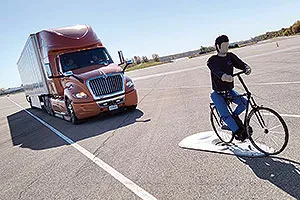
ADAS sensor technology has improved to better ensure road safety. (ZF Group)
Technology can see much more acutely than the human eye, and PlusDrive suggests a lane change in certain situations, such as when encountering a vehicle on the shoulder or a vehicle moving unsafely slower than the legal limit, Kerrigan said.
Manufacturers have rolled out other functionalities on the side that assist drivers. “We introduced the detection of traffic signs, high-beam assist and vulnerable road user detection, identifying the blind spot to detect pedestrians,” Wohltmann said.
More importantly, drivability is improving as technology is introduced or refined. “We can’t have the systems false alerting and false braking,” Thomas said.
Improving Driver Safety
Fleets are noticing the benefits. Boyle Transportation has been investing in ADAS technology for decades and deploys a solution that offers collision mitigation with AEB and blind spot warnings. “Boyle Transportation has not had a preventable recordable accident in over four years, and our average cost for all accidents over the last three years is less than $1,000 in each instance,” said Michael Lasko, the fleet’s vice president of environment, health and safety.
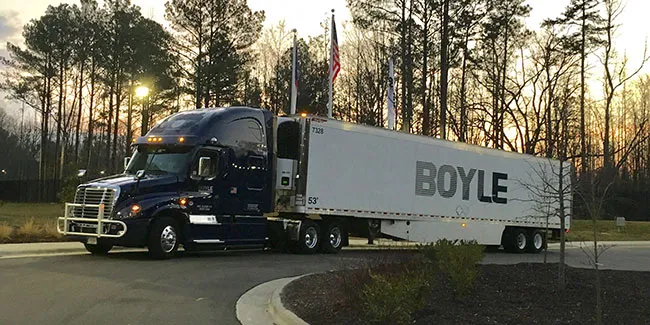
Boyle Transportation's use of ADAS has kept down accident costs. (Boyle Transportation)
Shawn Brown, vice president of safety for Cargo Transporters, said no single ADAS technology stands out, but the collective use of technology is a game changer. “The more of those things you can put together is where you’re seeing your efficiency increase and seeing the results.”

Brown
Data from ADAS can help fleets identify driver behaviors they need to correct, ultimately aiding driver retention. “If we can keep the driver we’ve got who might need to be coached or prevent a disciplinary action because of an accident, that is much better and much more advantageous for us as a company,” Brown said.
He has found that drivers appreciate the ADAS features. “Do they take some getting used to? Yes, they do,” Brown said. “There is an adjustment period for a driver, especially if they come to us from a company that didn’t have these features.”

Who's Who in the Autonomous Space
►Overview of Self-Driving Truck Development
Company Sketches
Click the links to jump to profiles of autonomous companies.
Aurora | Waymo | TuSimple | Gatik | Locomation | Torc Robotics | Waabi | Einride | Plus | Embark | Kodiak Robotics | Robotic Research | Outrider | Pronto
Features that add to drivers’ experiences provide operational value, but Thomas said it is less obvious. Bendix offers a road disturbance calibration that cuts down on the amount of vibration transmitted through the axle to the steering wheel. “The steering assist can account for that,” he said. “If you’re driving a truck 500 miles, and your wheel bounces less and is more stable, that reduces fatigue and makes the trip less stressful.”
Feedback from fleets and drivers has been positive, Kerrigan said. “They appreciate the stress reduction, the enhanced safety, the fuel savings and the ease-of-use because the system was designed by and for drivers,” he said, adding that some PlusDrive features have been tweaked because of driver input.
The first iteration of PlusDrive kept the truck moving at the speed limit, with adjustments to maximize fuel economy, but some drivers like the option of driving slightly below the speed limit in certain scenarios. Engineers changed the feature to allow for dynamic speed adjustment.
Lasko said better training and information sharing can help systems aid drivers better and increase driver acceptance. “The best professional drivers want and need detailed information on each of these systems, whether it is an explanation of audible and visual alerts or the ranges, parameters and levels of activation,” he said, noting that a lack of information in these areas can create a barrier to driver acceptance.
Kerrigan credits driver training as a vital component of the success Plus has experienced with PlusDrive. “As part of the training, it’s critical for the drivers to experience the ease of use of the technology, understand its capabilities, and see for themselves how the technology helps them directly,” he said.
Technician Impact

Legler
ADAS technology also is helping cut maintenance costs. “Adaptive cruise control can help you with brake wear and tear and tires relative to the vehicle operating more smoothly,” said Jack Legler, technical director of American Trucking Associations’ Technology & Maintenance Council. “That overall is going to improve maintenance in a lot of different areas.”
Bosch’s Chronicle said the advanced supporting technology also offers opportunities via additional diagnostics and connected services. “Our connected brake systems can offer insights into the health of the brake system and surrounding components,” he said.
Improving safety and reducing accidents also enhances uptime. “From that perspective, fleets will have better utilization of their assets and less maintenance due to vehicles staying on the road,” Chronicle said.
Lateral actuator systems, which provide automated steering input for functions like lane change assist and lane keeping support, can help reduce costs associated with property damage by up to 35%. Also, with ADAS, injuries from large truck crashes are potentially reduced by up to 23% and associated fatalities by up to 19%, Chronicle said.
ERoad's Craig Marris gives advice on carving out a practical, effective road map to a greener and more efficient fleet. Tune in above or by going to RoadSigns.ttnews.com.
The systems, however, require maintenance. TMC has created several recommended practices on ADAS maintenance. “You have to make sure sensors are calibrated and that you check them,” Legler said.
During pre-trip inspections, drivers need to ensure nothing is blocking the sensors and that there are no active faults on diagnostic trouble codes on the dash, Thomas said.
The Federal Motor Carrier Safety Administration is studying maintenance needs for sensors that support various levels of automation in commercial vehicles. The results of the project are in agency review, and FMCSA expects to publish the findings in 2024.
Brown said the costs to maintain the systems are insignificant compared to the benefits. “We put ADAS on, and it is money well spent,” he said.
With the number of solutions increasing, it is important for fleets to invest in the right solutions. “You don’t want to buy features you’re never going to use,” Legler said.
Want more news? Listen to today's daily briefing above or go here for more info
TMC has finished the appeals on a recommended practice for ADAS specification selection that will be published after TMC’s next annual meeting. “It covers the features you want for your particular duty cycle and operational profile,” Legler said. “It isn’t just the features but the settings on those features, making sure you get the vehicle spec’d and then provisioned with the settings done right for your operation.”
Rolling out connected technology increases cybersecurity risks, but Lasko said he sees the risks as being low. “However, as the technology improves and over-the-air capabilities develop, such as recent discussions on electronic inspections, this is something that the industry should keep a very close eye on.”
Thomas said Bendix works closely with OEMs to identify and address risks. “A side benefit of working with different OEMs is that we see different types of cybersecurity approaches,” he said.





